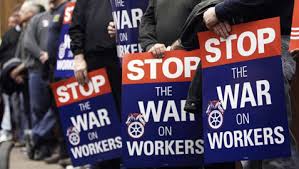by  Laura Kaminker, CUPE 966 and Peter Votsch, Chief Steward CUPE 3202
Laura Kaminker, CUPE 966 and Peter Votsch, Chief Steward CUPE 3202
The Canadian Union of Public Employees (CUPE) launched an important new workers’ rights campaign, Stand Up for Fairness (http://www.standupforfairness.ca/) in the Spring of 2013. It comes out of the experience of teachers and CUPE members with Bill 115, imposed by the McGuinty Liberals of Ontario that took away the right to meaningful bargaining and the right to strike.
Faced with this and other threats to union rights, particularly by Tim Hudak and his Progressive Conservatives, CUPE developed the campaign to reconnect the Local Union with its members. It’s a combination of a top-down and grassroots model. Volunteers in each Local are to sit down with every worker to have at least one conversation with them about the importance of having a trade union. Local presidents and unit chairs go for training, then set up training sessions for interested members. These members become “communicators” and are the frontline workers of the campaign.
Rank and File Strategy
Communicators reach out to members individually, having one-on-one discussions about why we need a union and the benefits for ourselves and society. Communicators ask the member to sign a pledge and give personal contact information (often members can only be reached through the employer). Communicators fill out a tracking form for each person they speak to. This communicates members’ concerns back up the chain, and identifies potential activists.
The one-on-one, member-to-member nature of this campaign is both a strength and a weakness. It is a breath of fresh air when members are allowed to lead a campaign – and it also reflects the seriousness of the threats facing unions today and in the near future. The communicators are learning about unions in general, about Canadian labour history, our part in the larger struggle and why we should be proud to belong to a union. The well-designed CUPE materials really help interested members get active in a way we could not do on our own.
On the negative side, it’s very slow going, and if we’re going to make a serious impact, we need more communicators. Although the actual education campaign is engaging rank and file members, the direction is still top-down, and there are many weak links along the way.
Holding the Union Leadership Accountable
More critically, it does not encourage steps beyond the campaign itself, such as members forming action committees to come up with ideas on how to fight the anti-union legislation. That will continue to be the decision of those at the top. More seriously, there seems not to be any action plan at all, or it is being kept secret. Members will inevitably ask, what are going to do if Hudak introduces Right to Work legislation – and this is a good question.
At the recent CUPE National Convention, CUPE spoke of rolling the campaign out nationally, as other right-wing parties throughout Canada, not to mention the federal Tories, are looking to attack us in the same way. There were also important speeches from the floor by Ontario CUPE leaders in particular, calling for “no concession” bargaining, and a return to the old traditions of the labour movement, such as mass strikes, and even possibly illegal ones.
It will be absolutely necessary to hold their feet to the fire on these claims. If Stand Up For Fairness is the beginning of moving towards a new strategy of mass action, one that did not materialize in the fight against Bill 115 (though some teachers unions played an important part in mobilizing their members), it is a good thing. But we need to know what the strategy is likely to be, so we can prepare our members now, especially if they’ve never been out on a demonstration or picket line before.
Lessons from Bill 115
There were a couple of lessons that emerged from the Bill 115 battle. One clearly is that we need better coordination with other public sector unions. There has been grumbling in CUPE about the teachers getting a better settlement from the Wynne government coming out of that battle than CUPE.
Attacking other unions for getting better settlements is not the way forward. Nor is allowing the union leadership to sell us out, while declaring victory when they make a deal. We can take the leadership at their word, but it will take action from the rank and file to convert words into action.
Next Steps
Connecting with every worker in the workplace is a good start. We will then need to take the Stand Up For Fairness campaign to the next level. Connecting Locals in each locality, so we can get to know each other, and our various issues, as we ready ourselves for mass action. If a Local bargaining committee says they cannot hold the line on a ‘no concessions’ stance, they will need our assistance. Militant words on the Convention floor have to backed up by action on the ground.
If we can begin to take these steps, we can begin to prepare ourselves for the massive attacks coming our way sooner or later. The stakes are very high – and it is rank and file workers that will bear the brunt if we are not successful. However if we are, we can set a model for future organizing, to take back what we have already conceded, and to move forward and take future concessions – from the employers.
